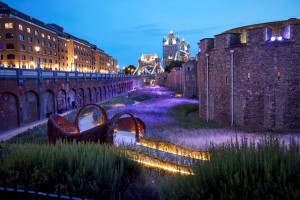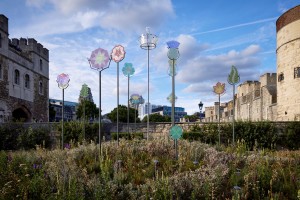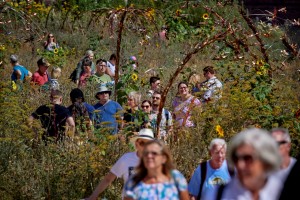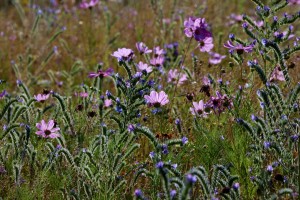Spaces in cities across the world will increasingly be repurposed to allow biodiversity to thrive, according to the Bath-based design team behind this year’s transformation of the historic Tower of London moat.
Landscape architects Grant Associates, which masterminded the design of the Superbloom experience, pictured, for Tower of London custodian Historic Royal Palaces, believes its success is just the first step towards a much wider phenomenon.

Grant Associates worked with leading horticulturist Nigel Dunnett of the University of Sheffield, soil scientist Tim O’Hare and an extensive team of design, creative and landscape specialists on the display, which marked the first time that the Tower’s moat had been opened up for the public to walk around at leisure.
The celebratory project sought to recognise the value and importance of nature to the collective wellbeing.
It featured a planting scheme of more than 20m seeds intentionally selected to provide visitors with a different experience whenever they came, all bolstered by an evocative soundscape and sculptures throughout.
A key feature of the display was the Queen’s Garden, developed by Andrew Grant and James Clarke of Grant Associates to recognise the Platinum Jubilee of the late Her Majesty Queen Elizabeth II.

Superbloom attracted more than 200,000 paying visitors and almost 30,000 education visitors between June to September, with a further 26,000 visitors enjoying its final blooms in late September after the entry fee was lifted.
The elegant garden took creative inspiration from the colours, shapes and motifs employed by famed British couturier Sir Norman Hartnell for The Queen’s 1953 coronation gown, with concentric scalloped hedging intended to evoke the scalloped tiers of embroidery which featured on the gown’s silk skirt.
Andrew Grant RDI, founder and director of Grant Associates, said Superbloom was always envisaged as an evolving landscape display that would shift and change colours and patterns, both this year and in the years to come.
“Its intention was to change the way visitors see and interact with the moat – and that’s been firmly accomplished this year,” he added.

“This has just been the first stage in what is set to be a long-term journey of biodiverse transformation for the site.
“In the years to come, the plants, wildlife and soil will all naturally adapt and evolve on the site, while the moat will continue to serve as an inspiring haven of nature at the very heart of the city of London.
“The project shows that, even in the most bustling and developed of urban environments, it is still possible to intentionally create powerful spaces that are full of life and where nature can thrive.”
HRP head of public engagement projects Rhiannon Goddard described Superbloom as a unique and ambitious undertaking for Historic Royal Palaces and the biggest change to the Tower moat since 1845.
“It has been a significant achievement to install a new landscape in the historic moat and to grow from seed a mass display of flowers as we emerged from the pandemic,” she added.

“Despite facing unprecedented weather conditions, the blooms looked beautiful, especially during July.
“We have learned a great deal about the microclimate of the moat which will take us forward into developing the landscape as a future attraction for visitors and home for pollinators and other wildlife.”
The Tower of London Superbloom will continue to be closely overseen by HRP, Grant Associates and the wider project team, to ensure that it flourishes into a long-term habitat and green haven for pollinators, insects and seed-eating birds alike.
Grant Associates, which also has an office in Singapore – where it helped create the city-state’s spectacular Gardens by the Bay – has also worked on major projects in the Far East, Australia and the UK, including supporting Bath’s Forest of Imagination community arts event. It also won the Best Show Garden at last year’s Chelsea Flower Show.
This summer the environmentally focused practice collaborated on the regeneration of a scheme in Croydon, South London, with revitalised green spaces and a new play area sensitively integrated into its sunken gardens on the site of a former 1960s office scheme.
Earlier this month its design for a six-hectare sustainable public park at Brabazon, the 2,600-home new neighbourhood being built on the historic former Filton Airfield, north of Bristol, received planning permission. It will be the largest new urban public park to be created in the South West for 50 years.


















